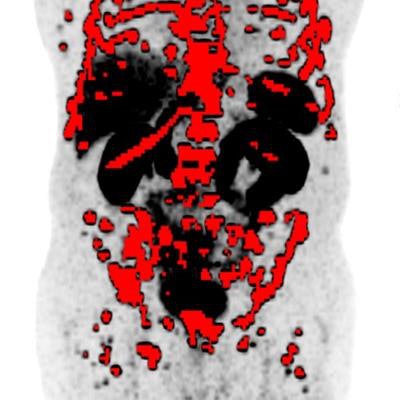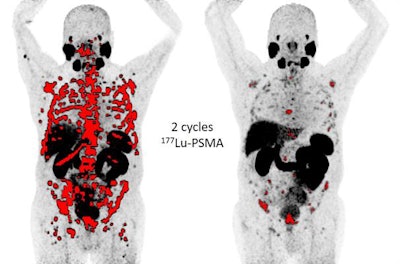
ANAHEIM, CA - Adding an interim prostate-specific membrane antigen (PSMA)-PET scan during therapy can help guide treatment for patients with prostate cancer, according to a study presented Sunday at the Society of Nuclear Medicine and Molecular Imaging (SNMMI) annual meeting.
German researchers found that evaluating PET images after two cycles of lutetium-177 (Lu-177) PSMA radioligand therapy better predicted the overall survival for patients with metastatic castration-resistant prostate cancer.
"Our results, therefore, show that interim PSMA-PET can be used for therapeutic response assessment in patients undergoing Lu-177 PSMA radioligand therapy," noted Dr. Andrei Gafita, from the department of nuclear medicine at Technical University Munich, in an SNMMI statement.
In previous studies, Lu-177 PSMA therapy has achieved promising results in treating patients with metastatic castration-resistant prostate cancer. The therapy typically involves a preliminary gallium-68 (Ga-68) PSMA PET scan to identify patients who are eligible for the treatment.
"While interim PET scans have shown high predictive value for lymphoma patients, this concept has not been previously explored in prostate cancer patients undergoing Lu-177 PSMA therapy," SNMMI added.
Given that the five-year survival rate for men with metastatic prostate cancer is 30.5%, according to the National Cancer Institute, it is critical that oncologists assess the efficacy of treatment early in a regimen to adjust the therapy if necessary.
For this study, Gafita and colleagues analyzed patients who underwent a gallium-68 (Ga-68) PSMA PET/CT at baseline and again after two cycles of Lu-177 PSMA radioligand therapy. The researchers then used quantitative PSMA software to assess tumor burden assessment, using a fixed standardized uptake value (SUV) threshold of 3 for bone lesions segmentation and a liver-based SUV threshold for soft-tissue lesions characterization.
 Lu-177 PSMA PET images illustrate the spread of cancer, or lack thereof (red areas), in two different patients with metastatic castration-resistant prostate cancer. Images courtesy of Dr. Andrei Gafita et al and SNMMI.
Lu-177 PSMA PET images illustrate the spread of cancer, or lack thereof (red areas), in two different patients with metastatic castration-resistant prostate cancer. Images courtesy of Dr. Andrei Gafita et al and SNMMI.Treatment response primarily was based on changes in PSMA-avid tumor volume of more than or less than 30% from baseline PSMA-PET scans to follow-up imaging.
In reviewing the results after two rounds of Lu-177 PSMA radioligand treatment, tumor volume decreased by a median of 9%, while median overall survival was 11.3 months (range, 8.7-13.9 months). Patient response to the treatment, the development of new lesions, and the progression of prostate cancer and metastases also influenced median overall survival, which ranged from 16.5 months to 6.2 months.
"While further analyses involving clinical parameters are warranted, this analysis paves the way for use of interim PSMA-PET in a prospective setting during Lu-177 PSMA radioligand therapy," Gafita stated. "Furthermore, occurrence of new lesions in PSMA-PET is a prognostic factor for disease progression and should be included in defining tumor response based on PSMA-PET imaging."



















